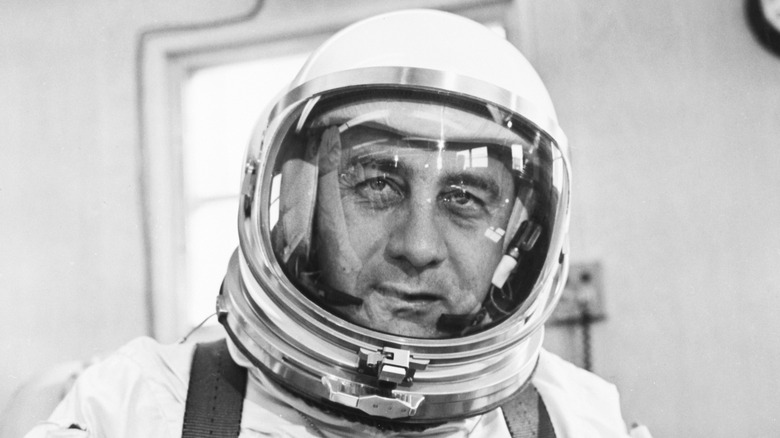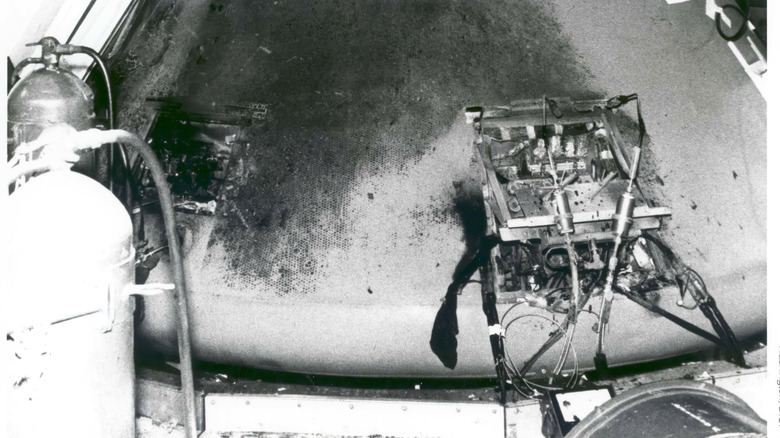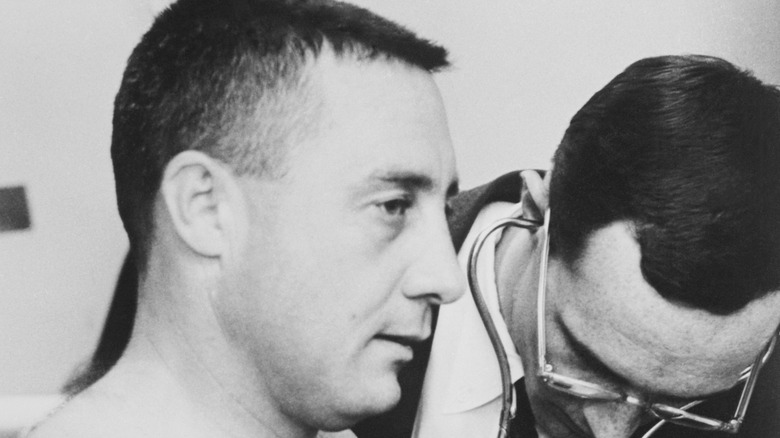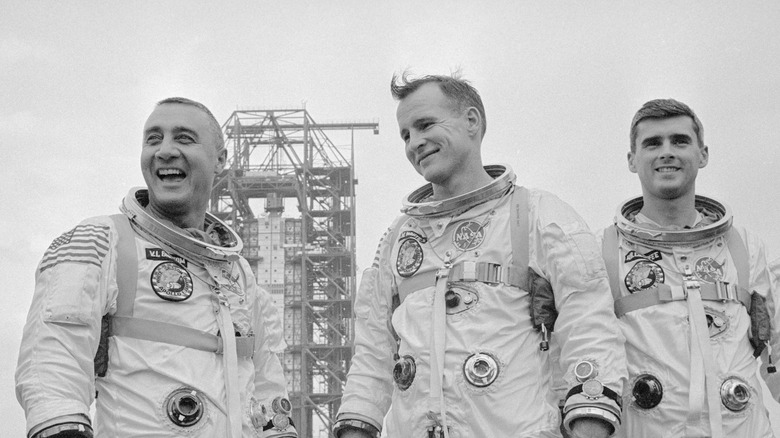Disturbing Details Found In Gus Grissom's Autopsy Report
United States astronaut Virgil "Gus" Grissom sat inside the Apollo 204 (later renamed Apollo 1) Command Module with the two other members of the mission — Edward White II and Roger Chaffee. It was January 27, 1967, and they were less than a month away from the program's first planned manned mission to achieve a low-Earth orbit and test the system that would eventually lead to the moon landing. Several hours into the test of the spacecraft that included routine inspections and troubleshooting at Cape Kennedy Launch Complex 34 in Florida, something went horribly wrong.
At 6:31 p.m EST, White shouted "Fire!" In the Mission Control Center, the technicians could see his pulse rate suddenly jump and detected movement from all three men. "I've got a fire in the cockpit!" Grissom, the command pilot, shouted into his headset (via NBC News). These were the chilling final words of Grissom, the second man from the U.S. to travel in space. The final transmission from Apollo 1 came from one of the other astronauts: "Get us out!" In mere minutes, all three astronauts were dead from asphyxiation. According to the Apollo 1 autopsies, they'd gone into cardiac arrest brought on by high concentrations of carbon monoxide and other gasses in the Command Module.
Technicians were too late to save the Apollo 1 crew
Inside the Command Capsule, in the desperate few minutes after the fire engulfed them, Ed White frantically tried to remove the heavy two-part hatch that took almost two minutes to open in perfect conditions. He'd managed to begin the hatch-opening procedure, but because of the pressure inside the cabin, couldn't get it open in time.
Meanwhile, on the outside of Apollo 1, NASA technicians scrambled to get the men out. They fought immense smoke and heat as they attempted to get the various hatches off. They got the Command Module opened in less than five minutes, but 27 of them suffered smoke inhalation in doing so. When the technicians raked their flashlights into the charred interior, they found all three astronauts dead. Grissom lay on the capsule floor with his helmet on, and he had almost managed to get his harness off. The heat had been so intense Grissom's and White's spacesuits had become fused to one another.
Virgil Ivan Grissom was born in 1926 in Indiana. He served in the Korean War as an Air Force fighter pilot and eventually became a test pilot. In 1959, NASA chose him to be one of the first seven U.S. astronauts, known as the Mercury 7. After becoming the second U.S. astronaut into space in 1961, he commanded Gemini 3 as it orbited the earth three times. The Apollo program should have been the apex of his career, but instead, it was the end.
What Gus Grissom's autopsy revealed
By the time NASA technicians were able to get to the Apollo 1 crew, they were beyond resuscitation. It took them about seven hours to remove the men's bodies due to factors such as remaining smoke and fumes and the fusion of their spacesuits to the extensive nylon equipment within the capsule. According to "The Apollo Spacecraft: A Chronology," three military pathologists conducted the autopsies on Grissom and the other crew members the next morning, finishing at 1 a.m. on January 29.
While the Apollo 1 autopsies were never made public, the various NASA and other governmental reports following the tragedy cited them frequently. Based on Grissom's autopsy and the ensuing investigation into the calamity, he (and his fellow astronauts) passed out from the gasses inside the cabin after one of their spacesuits became breached (they shared the same oxygen system) and died shortly after. Multiple factors — carbon dioxide, carbon monoxide, oxygen, and irritant levels — were blamed for the astronauts' rapid deaths.
The pathologists found soot in Grissom's trachea, oral cavity, bronchi, and nose. His official cause of death was noted as "asphyxia due to inhalation of toxic gases due to fire." Grissom also suffered burns on 60% of his body, and thermal burns were considered a contributing factor to his and the other men's death. All three astronauts' space suits were burnt "to some degree" and wouldn't have protected their bodies from such an intense fire.
What went wrong with Apollo I
A government investigation into the tragic Apollo 1 mission determined that the most likely cause of the fire was an exposed wire beneath Gus Grissom's seat. NASA used Teflon to cover the cable, which, while flame-resistant, is also easily damaged. The combination of faulty wiring and the decision to use highly combustible pure oxygen in the Command Module made for a deadly combination. This, along with several other design flaws and poor decision making from the higher ups at NASA and its main contractor, North American Aviation, helped precipitate the Apollo 1 disaster (and the worst part of it isn't even what you think).
On January 31, 1967, the bodies of the Apollo 1 crew, Grissom, Ed White, and Roger Chaffee, were laid to rest at Arlington National Cemetery. U.S. President Lyndon B. Johnson led the graveside service that included a gun salute and jets streaking across the sky. "He was one of the great heroes of the space age," the Rev. Roy Van Tassel said during his eulogy for Grissom (via the La Crosse Tribune). The tragedy pushed NASA to completely redesign the Apollo program. The agency instituted new safety measures, a new hatch design, and began using a more stable oxygen-nitrogen mix. These and other changes helped get U.S. astronauts to the surface of the moon and back safely two years later.



